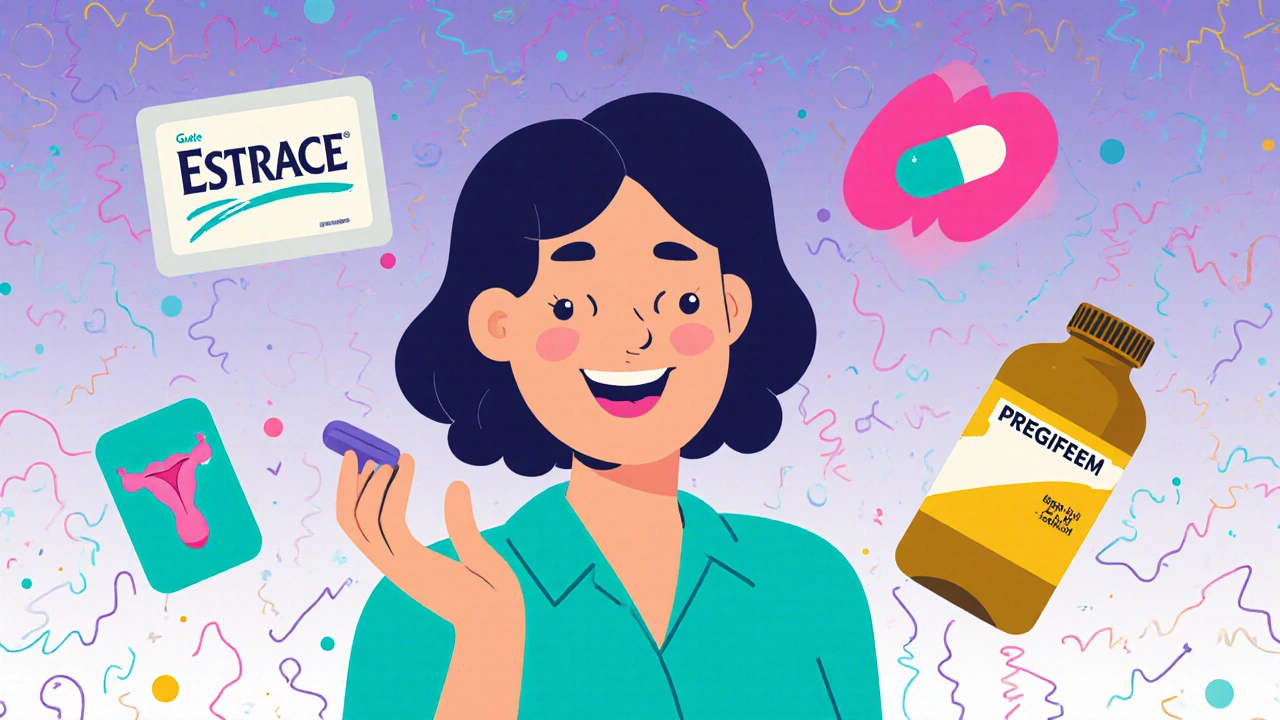Estrogen Therapy Comparison Tool
Find the Best Estrogen Therapy for You
Answer a few questions about your symptoms and health history to get personalized recommendations.
Your Symptoms
Your Preferences
When it comes to easing menopausal symptoms, Estrace often shows up on the prescription list, but it’s not the only player. Knowing how Estrace stacks up against other estrogen options can save you from unwanted side effects, unexpected costs, or a treatment that just doesn’t fit your lifestyle.
Quick Takeaways
- Estrace is an oral micronized estradiol tablet, praised for its predictable blood levels.
- Transdermal patches (e.g., Climara, Vivelle‑Dot) bypass the liver, reducing clot risk.
- Premarin delivers conjugated equine estrogens, a mix of several estrogen types.
- Vagifem provides low‑dose vaginal tablets, ideal for local symptoms.
- Choosing the right product depends on route of administration, cardiovascular profile, cost, and personal preference.
What Is Estrace?
Estrace is a brand-name oral medication whose active ingredient is micronized estradiol, the same hormone the ovaries produce before menopause. It belongs to the class of estrogen replacement therapies and is FDA‑approved for treating moderate to severe vasomotor symptoms, preventing bone loss, and managing urogenital atrophy.
Typical dosing starts at 0.5 mg daily, with adjustments up to 2 mg based on symptom control and serum estradiol levels. Because it’s taken by mouth, estradiol undergoes first‑pass metabolism in the liver, which can raise triglycerides and affect clotting factors.
How to Pick the Right Estrogen Therapy
Before diving into the side‑by‑side table, consider these decision criteria:
- Route of administration: Oral, transdermal, vaginal, or injectable each have distinct absorption patterns.
- Cardiovascular risk: Women with a history of thrombosis often benefit from non‑oral routes.
- Symptom focus: Hot flashes versus vaginal dryness may call for different formulations.
- Cost and insurance coverage: Generic versions can be dramatically cheaper.
- Convenience: Daily pills vs. weekly patches vs. monthly injections.

Comparison Table: Estrace and Common Alternatives
| Product | Formulation | Typical Dose | Primary Use | Pros | Cons |
|---|---|---|---|---|---|
| Estrace | Oral micronized estradiol | 0.5‑2 mg daily | Systemic hot‑flash relief, bone protection | Predictable dosing, widely available | First‑pass liver metabolism, higher clot risk |
| Premarin | Oral conjugated equine estrogens | 0.3‑1.25 mg daily | Broad estrogen replacement | Long‑standing data, inexpensive generic | Mixed estrogen types, higher breast‑cancer concerns |
| Estradiol Transdermal Patch | Skin‑applied patch (e.g., Climara, Vivelle‑Dot) | 0.025‑0.1 mg/24 h, changed 1‑2 times weekly | Systemic symptom control without liver first‑pass | Lower thrombosis risk, steady hormone levels | Skin irritation possible, higher out‑of‑pocket cost |
| Vagifem | Vaginal estradiol tablets | 10‑25 µg inserted 2‑3 times weekly | Local vaginal dryness, dyspareunia | Minimal systemic absorption, inexpensive | Not effective for hot flashes, requires insertion |
| Femtrace | Oral micronized estradiol (generic) | 0.5‑2 mg daily | Same indications as Estrace, lower brand cost | Same efficacy, cheaper | Shares oral‑route drawbacks |
| Compounded Bioidentical Hormone Therapy | Custom‑mixed estradiol creams, pills, pellets | Variable, tailored by pharmacist | Patients seeking “natural” hormones | Individualized dosing, can avoid certain additives | Limited FDA oversight, variable purity, higher cost |
Deep Dive Into Each Alternative
Premarin (Conjugated Equine Estrogens)
Premarin combines several estrogen molecules derived from pregnant mare’s urine. It’s been on the market since the 1940s and is still prescribed for hot flashes, osteoporosis prevention, and urogenital atrophy.
Because it contains a mix of estrone sulfate and other estrogens, it can produce a broader hormonal effect, but that also means slightly higher breast‑tissue stimulation. Women with a personal or family history of estrogen‑sensitive cancers often opt for a more “pure” estradiol product instead.
Estradiol Transdermal Patch (Climara, Vivelle‑Dot)
Climara (and its equivalents) delivers estradiol through the skin. The patch bypasses the liver, which reduces the impact on clotting factors and triglyceride levels.
Clinical data from the Mayo Clinic shows a roughly 30 % lower incidence of venous thromboembolism compared with oral estradiol in women over 60. The downside is skin irritation for about 5‑10 % of users and a higher price tag not always covered by insurance.
Vagifem (Intravaginal Estradiol Tablet)
Vagifem is a tiny 10‑µg estradiol tablet placed inside the vagina. It’s perfect for addressing dryness, itching, and painful intercourse without flooding the bloodstream with estrogen.
Because systemic absorption is minimal (often <0.1 % of the oral dose), the risk of clotting or breast‑cancer stimulation is negligible. However, it won’t help with night sweats or hot flashes, so many clinicians pair it with a low‑dose oral or patch product.
Femtrace (Generic Micronized Estradiol)
Femtrace offers the same active ingredient as Estrace but at a fraction of the cost. It’s FDA‑approved and comes in 0.5 mg and 1 mg tablets.
Patients who are price‑sensitive often switch to Femtrace after a trial period with the brand name. The efficacy and side‑effect profile are essentially identical, as the only difference is the manufacturer.
Compounded Bioidentical Hormone Therapy (BHRT)
Some women prefer “bioidentical” hormones that match the molecular structure of human estradiol. Compounded pharmacies can create creams, gels, or pellets customized to a patient’s blood‑test results.
While the concept sounds appealing, the FDA has warned that compounded products are not subject to the same rigorous testing as approved drugs. Purity can vary, and insurance rarely covers them, leading to out‑of‑pocket expenses of $200‑$400 per month.
Putting It All Together: How to Choose
Imagine you’re a 55‑year‑old experiencing nightly hot flashes and mild pelvic dryness. You have a family history of deep‑vein thrombosis but no breast‑cancer concerns. Here’s a quick decision flow:
- If clot risk is a priority, start with a trans‑dermal patch (Climara) for systemic relief.
- Add Vagifem for local vaginal symptoms.
- If patches feel pricey, consider generic oral estradiol (Femtrace) but monitor lipid panels and clotting tests.
- Avoid Premarin because its mixed estrogens raise clotting factors slightly more.
Always discuss these options with your prescribing clinician. Blood work (estradiol level, lipid profile, coagulation studies) can guide dose tweaks.

Practical Tips for Your Doctor Visit
- Bring a symptom diary: note hot‑flash frequency, severity, and any vaginal discomfort.
- Ask about insurance coverage for each option; sometimes a patch is covered if you have a high‑risk profile.
- Request baseline labs: fasting lipids, liver enzymes, and a coagulation panel.
- Clarify the plan for tapering off therapy; most guidelines recommend the lowest effective dose after 3‑5 years.
Frequently Asked Questions
Is oral estradiol more dangerous than a patch?
Oral estradiol passes through the liver first, which can raise clotting factors and triglycerides. Patches deliver hormone directly into the bloodstream, lowering those risks. For women with a personal clotting history, a patch is usually the safer pick.
Can I use Vagifem alone if I only have hot flashes?
Vagifem’s absorption is so low that it won’t relieve systemic symptoms like hot flashes. You’d need an additional oral or trans‑dermal estrogen to target those.
What’s the cost difference between Estrace and Femtrace?
Estrace (brand) typically runs $80‑$120 for a 30‑day supply, while Femtrace (generic) is often $20‑$35 for the same dose, depending on pharmacy pricing.
Are compounded bioidentical hormones worth the extra cost?
Compounded BHRT can be useful for very specific dosing needs, but the lack of FDA oversight means purity and potency can vary. Most clinicians recommend FDA‑approved estradiol options first, reserving compounding for rare cases.
How long should I stay on estrogen therapy?
Guidelines suggest using the lowest effective dose for 3‑5 years, then reassessing. Some women continue longer if symptoms persist and risk factors are low, but regular check‑ups are essential.
Next Steps
Grab a notebook, list your top three symptoms, and schedule a follow‑up with your healthcare provider. Bring this comparison sheet so you can ask specific questions about dosage, cost, and risk. If insurance coverage is tight, ask the pharmacist about generic alternatives like Femtrace or discount programs for patches.
Remember, hormone therapy isn’t one‑size‑fits‑all. The right choice balances effectiveness, safety, convenience, and your budget.


4 Comments
Alex Pegg
October 20, 2025 AT 20:04Oral estradiol may look convenient, but it’s a relic compared to transdermal options.
Sebastian Green
November 2, 2025 AT 13:31I get why some stick with the pill, but the liver‑first pass really can crank up clot risk, especially if you’ve got a family history of thrombosis. A patch sidesteps that and still gives steady relief.
Wesley Humble
November 15, 2025 AT 06:58From a pharmacokinetic perspective, oral micronized estradiol undergoes extensive first‑pass metabolism, thereby increasing hepatic synthesis of clotting factors and triglycerides 😊. This mechanism differentiates it markedly from transdermal delivery, which provides more physiologic serum estradiol concentrations without hepatic activation 🙌.
Vijaypal Yadav
November 28, 2025 AT 00:24To add, the conjugated equine estrogens in Premarin contain multiple estrogenic compounds, which can lead to variable serum levels and potentially higher breast tissue stimulation compared to pure estradiol formulations.